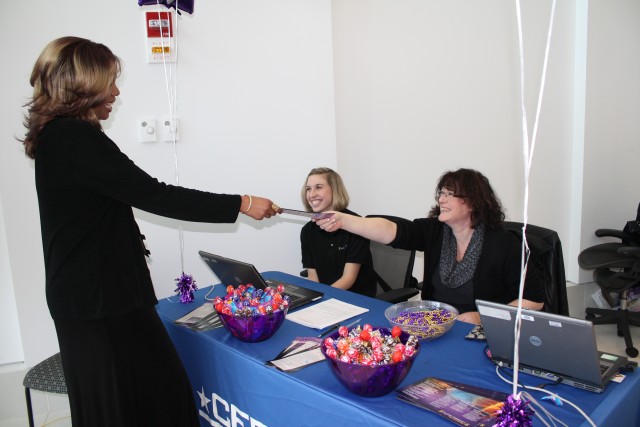ABERDEEN PROVING GROUND, Md., Feb. 18, 2011 -- U.S. Army eCYBERMISSION reached its 2011 goal when the 1,000th volunteer virtual judge signed up during the final stop of its road show here, Feb. 9.
Sponsored by the U.S. Army Research, Development and Engineering Command, eCYBERMISSION is a free, web-based science, technology, engineering and math - or STEM - competition for students in grades six through nine.
For the first time, RDECOM's communications-electronics center, or CERDEC, hosted the event at its new APG facilities.
"What sets eCYBERMISSION apart from a lot of the other STEM programs and makes it really exciting is that it doesn't just focus on students who already have an interest or aptitude in science, engineering, technology or math. eCYBERMISSION really looks for those kids who are creative, who are looking at their community, seeing the problems and trying to fix them," said Erica Bertoli, program manager for CERDEC Outreach.
"It's about the kids learning that engineering and critical thinking are as much about creativity as they are anything else - instilling the idea that innovation is born when innate creativity is paired with critical thinking," Bertoli said.
The eCYBERMISSION competition encourages and rewards students from a diverse range of proficiency levels, interests and backgrounds, while teaching them that team work, innovation, creativity and real-life applications of STEM education can have a positive impact on their communities, and their future.
Students identify a problem in their community, as it relates to one of nine pre-determined Mission Challenges, or topics. They then use the scientific method to research the problem, hypothesize solutions, conduct experiments to test their hypotheses and draw conclusions from the data they collect to propose a potential solution.
During the CERDEC-hosted event, 73 volunteers from across team C4ISR registered to serve as virtual judges during this year's competition.
"CERDEC scientists and engineers have always shown strong support and enthusiasm for eCYBERMISSION and other Army Educational Outreach Programs. We are thrilled they were responsible for registering our 1000th Virtual Judge for the 2010-2011 eCYBERMISSION competition," said U.S. Army eCYBERMISSION Program Manager Katie Blanding.
The success was due to a cross-organizational effort across the C4ISR community, Bertoli said.
"Not only was CERDEC out there, but you had the Software Engineering Center and the Communications-Electronics Command getting people from their organizations down and making the push to make sure that the entire event was going to be successful," Bertoli said.
Virtual Judges can have varying backgrounds and areas of expertise, but must have an interest in promoting science, math and technology. They independently evaluate and score approximately 20 mission folders on-line. Virtual Judges can review their assigned mission folders from anywhere that has an Internet connection.
The competition provides awards at the state, regional and national levels. Students on winning teams can win up to $8,000 in U.S. EE Savings Bonds and the first-place team in each grade and region wins an all-expenses-paid trip to the Baltimore-Washington Metropolitan Area for the national competition.
Last year's national winners went to the White House where they presented their project to President Barack Obama as part of the White House Science Fair.
"If we want to win the future, if we want innovation to produce jobs in America and not overseas, then we also have to win the race to educate our kids," President Obama said during his State of the Union address, Jan. 25. "We need to teach our kids that it's not just the winner of the Super Bowl who deserves to be celebrated, but the winner of the science fair."
President Obama hopes to prepare 100,000 new teachers in the fields of science, technology, engineering and math over the next 10 years.
"Math and science do so much for this country," said Jill Smith, CERDEC technical director. "They support everything from space programs to our homeland security and economic well being."
"If we only had to get our math and science from outside of this country, in time we would be well behind in economics and our security would be at risk," Smith explained. "If you think about the alternative to not having a strong infrastructure in math and science, it's a pretty bleak outcome."
"Our outreach goal is to have everyone who works for us contributing in some way to STEM education, whether that be in their children's schools, or Army-sponsored programs like eCYBERMISSION. Everybody should give back in some way because we have a responsibility to try to bring others in to follow in our footsteps," Smith said.
Since 2002, more than 71,000 students from across the nation and in Department of Defense Education Activity schools have participated in eCYBERMISSION, and the U.S. Army has awarded over $7.8 million in U.S. EE Savings Bonds in support of STEM education.
"The expertise of our future workforce begins today with our sixth through ninth graders, whose interests are now being molded," said Michael Skurla, director of the CERDEC Software Engineering Directorate, who volunteered to judge this year.
"Look how technology changes. We've gone from records, to eight tracks and cassettes to CDs to iPods. Where are we going to be tomorrow' These kids are going to decide that, and that's why it's so important to engage them in math and science - so they can understand the opportunities available," Skurla said.
The eCYBERMISSION judging period is March 1 through March 29, 2011.
Related Links:
Army.mil: Science and Technology News
Research, Development and Engineering Command
STAND-TO!: Army Science and Technology
Communications-Electronics Research, Development and Engineering Center


Social Sharing